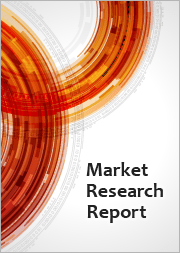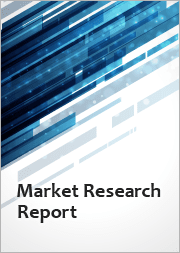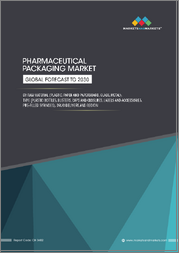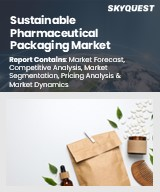
|
시장보고서
상품코드
1615897
세계의 의약품 포장 장비 시장 규모 : 제품별, 패키지별, 지역별, 범위 및 예측Global Pharmaceutical Packaging Equipment Market Size By Product (Liquids Packaging Equipment, Solids Packaging Equipment), By Package (Primary Packaging Equipment, Secondary Packaging), By Geographic Scope And Forecast |
||||||
의약품 포장 장비 시장 규모 및 전망
의약품 포장 장비 시장은 2024년 85억 달러로 평가되며 2024년부터 2031년까지 연평균 6.7% 성장하여 2031년에는 142억 달러에 달할 것으로 예상됩니다. 의약품 포장 장비는 의약품 포장 공정에 사용되는 특수 기계와 도구를 말합니다. 이 장비는 의약품의 유효성, 안전성 및 품질을 유지하기 위해 의약품이 안전하게 포장되어 의약품의 수명주기 동안 유효성, 안전성 및 품질을 유지하는 데 중요한 역할을 합니다. 의약품 포장 장비의 주요 기능은 의약품을 오염, 열화 및 물리적 손상으로부터 보호하는 방식으로 의약품을 포장하는 것입니다. 여기에는 충전, 밀봉, 라벨링, 오버랩 및 기타 프로세스가 포함됩니다.
최신 의약품 포장 시스템의 대부분은 효율성을 높이고 인적 오류를 줄이기 위해 자동화되어 있습니다. 자동화는 일관된 품질을 유지하면서 더 높은 처리량을 달성하는 데 도움이 됩니다.
의약품 포장 장비는 종종 다른 생산 시스템(생산 라인, 재고 관리 시스템 등)과 통합되어 워크 플로우를 간소화하고 전반적인 업무 효율성을 향상시킵니다.
의약품 포장 장비 세계 시장 역학
세계 의약품 포장 장비 시장을 형성하는 주요 시장 역학
주요 촉진요인
기술의 진보:
기술적 진보: 자동화 및 스마트 포장 솔루션과 같은 패키징 기술의 지속적인 혁신은 패키징 공정의 효율성을 높이고 오류를 줄이는 데 도움이 됩니다. 이러한 발전은 규제 기준을 충족하고 제품 안전성을 향상시키는 데 매우 중요합니다.
규정 준수:
전 세계 보건 당국의 엄격한 규제로 인해 안전 및 품질 표준을 준수할 수 있는 첨단 패키징 솔루션이 요구되고 있습니다. 예를 들어, 다양한 규제 기관이 제조업체가 준수해야 할 가이드라인을 제시함에 따라 특수 포장 장비에 대한 필요성이 증가하고 있습니다.
환자의 안전과 편의성 중시:
소아용 포장, 개봉하기 쉬운 디자인 등 사용 편의성과 안전성을 높이는 환자 중심의 포장 솔루션에 대한 관심이 높아지고 있습니다. 이러한 추세는 환자의 복약 순응도를 향상시키는 데 있어 매우 중요합니다.
지속가능성을 위한 노력:
환경 문제에 대한 인식이 높아짐에 따라 제약회사들은 지속가능한 포장 솔루션을 채택하고 있습니다. 이러한 변화는 재활용 가능한 재료와 같은 환경 친화적인 관행을 지원하는 혁신적인 장비에 대한 수요를 촉진하고 있습니다. 예를 들어, 미국 환경보호청(EPA)은 포장 효율성과 재활용성 향상으로 인해 2023년 의약품 포장 폐기물이 2022년 대비 12% 감소할 것으로 예상하고 있습니다.
주요 과제
높은 설비 비용:
첨단 의약품 포장 장비에 필요한 초기 투자는 특히 중소기업에 있어서는 매우 높은 초기 투자비용이 소요될 수 있습니다. 업계 보고서에 따르면 많은 중소기업은 대기업에 비해 예산이 부족하여 신기술에 투자하는 초기 비용을 정당화하기 어렵다고 합니다. 이러한 경제적 장벽은 최신 패키징 솔루션을 채택하는 능력을 제한할 수 있습니다.
숙련된 노동력 부족:
첨단 포장 장비의 운영 및 유지보수에는 전문 지식을 갖춘 숙련된 인력이 필요합니다. 제약 업계는 유능한 인력이 부족하여 새로운 기술 도입에 어려움을 겪을 수 있습니다. 복잡한 기계에 대한 직원 교육에 많은 시간과 비용이 소요되는 경우가 많으며, 이는 포장 역량을 강화하려는 기업의 상황을 더욱 복잡하게 만듭니다.
환경 규제:
환경 안전 및 지속가능성에 대한 정부 규제가 점점 더 엄격해지고 있으며, 이는 의약품 포장에 사용되는 재료의 종류에 영향을 미치고 있습니다. 예를 들어, 플라스틱 사용을 줄이기 위한 규제로 인해 제조업체는 대체 재료 및 대체 공정에 투자해야 할 수 있으며, 이는 운영 비용을 증가시킬 수 있습니다.
위조품:
위조 의약품의 증가는 제약 업계에 큰 도전이 되고 있습니다. 각국 정부는 이 문제를 해결하기 위해 보다 엄격한 시리얼라이제이션 및 추적 요건을 도입하고 있으며, 이는 제조 공정을 복잡하게 만들고 비용을 증가시킬 수 있는 첨단 패키징 기술에 대한 투자를 요구하고 있습니다.
주요 동향
기술의 진보:
자동화와 스마트 포장 기술에 대한 관심이 높아지고 있습니다. 추적 시스템 통합은 의약품의 추적성을 강화하고 위조품에 대응하기 위해 규제 준수에 있어 점점 더 중요해지고 있습니다. 예를 들어, 미국 특허청은 2023년에 3,500건의 의약품 포장 기술 관련 특허를 부여했으며, 이는 2022년 대비 15% 증가한 수치입니다.
패키징 서비스 아웃소싱 증가:
제약사들은 비용 절감과 효율성 향상을 위해 포장 수요를 포장 위탁업체(CPO)에 아웃소싱하는 사례가 증가하고 있습니다. 이러한 추세는 CPO가 다양한 고객 요구에 대응하기 위해 역량을 확대함에 따라 포장 장비에 대한 수요를 꾸준히 증가시키고 있습니다.
규제 준수에 대한 압력:
세계 각국 정부가 의약품 포장에 대한 엄격한 규제를 시행함에 따라 기업들은 안전과 품질 기준을 준수할 수 있는 첨단 기술에 투자해야 합니다. 이러한 규제 환경은 변화하는 요구 사항에 대응할 수 있는 새로운 패키징 솔루션에 대한 혁신과 투자를 촉진합니다.
만성질환 발생률 상승:
전 세계적으로 만성질환의 확산으로 더 많은 의약품이 필요함에 따라 품질 저하 없이 더 많은 생산량을 처리할 수 있는 효율적인 패키징 솔루션에 대한 수요가 증가하고 있습니다.
목차
제1장 의약품 포장 장비 세계 시장 : 소개
- 시장 개요
- 조사 범위
- 가정
제2장 주요 요약
제3장 Verified Market Intelligence 조사 방법
- 데이터 마이닝
- 검증
- 1차 자료
- 데이터 소스 리스트
제4장 의약품 포장 장비 세계 시장 전망
- 개요
- 시장 역학
- 성장 촉진요인
- 성장 억제요인
- 기회
- Porter's Five Forces 모델
- 밸류체인 분석
- 규제 프레임워크
제5장 의약품 포장 장비 세계 시장 : 제품별
- 개요
- 액체 포장 장비
- 무균 액체 포장 장비
- 에어로졸 포장 장비
- 시럽 포장 장비
- 점이/점안제 포장 설비
- 기타
- 고형물 포장 설비
- 정제 포장 장비
- 과립 포장 설비
- 캡슐 충전 포장기
- 분말 포장 설비
- 기타
- 반고형물 포장 설비
- 좌제 포장 설비
- 연고 포장 설비
- 크림 포장 설비
- 기타
제6장 의약품 포장 장비 세계 시장 : 패키지별
- 개요
- 1차 포장 장비
- 무균 충전 밀봉 장비
- 사쉐 포장 장비
- 계수기
- 스트립 포장기
- 보틀 충전 포장기
- 블리스터 포장기
- 기타
- 2차 포장
- 카토닝 장비
- 트레이 포장기
- 케이스 포장기
- 포장 장비
- 팔레타이징·디팔레타이징 장비
- 라벨·시리얼라이제이션 장비
- 보틀·앰플용 라벨·시리얼라이제이션 장비
- 카톤 라벨·시리얼라이제이션 장비
- 데이터 매트릭스 라벨링·시리얼라이제이션 장비
제7장 의약품 포장 장비 세계 시장, 지역별
- 개요
- 북미
- 미국
- 캐나다
- 멕시코
- 유럽
- 독일
- 영국
- 프랑스
- 기타 유럽
- 아시아태평양
- 중국
- 일본
- 인도
- 기타 아시아태평양
- 세계 기타 지역
- 라틴아메리카
- 중동 및 아프리카
제8장 세계의 의약품 포장 장비 시장 경쟁 구도
- 개요
- 기업 시장 점유율
- 벤더 상황
- 주요 발전 전략
제9장 기업 개요
- Romaco Pharmatechnik GmbH
- MULTIVAC
- Marchesini Group S.p.A.
- Korber Ag
- Robert Bosch Gmbh
- MG2 s.r.l.
- Uhlmann-Group
- OPTIMA packaging group GmbH
- I.M.A. Industria Macchine Automatiche S.p.A.
- Bausch & Strobel Maschinenfabrik llshofen Gmbh Co. Kg.
제10장 주요 발전
- 제품 출시/개발
- 인수합병
- 사업 확대
- 파트너십과 제휴
제11장 부록
- 관련 조사
Pharmaceutical Packaging Equipment Market Size And Forecast
Pharmaceutical Packaging Equipment Market was valued at USD 8.5 Billion in 2024 and is anticipated to reach USD 14.2 Billion by 2031 , growing at a CAGR of 6.7% from 2024 to 2031. Pharmaceutical packaging equipment refers to specialized machinery and tools used in the packaging process of pharmaceutical products. This equipment plays a critical role in ensuring that medications are safely packaged to maintain their efficacy, safety, and quality throughout their lifecycle. The primary function of pharmaceutical packaging equipment is to package drugs in a manner that protects them from contamination, degradation, and physical damage. This includes processes such as filling, sealing, labeling, and overwrapping.
Many modern pharmaceutical packaging systems are automated to enhance efficiency and reduce human error. Automation helps in achieving higher throughput while maintaining consistent quality.
Pharmaceutical packaging equipment often integrates with other manufacturing systems (e.g., production lines, inventory management systems) to streamline workflows and improve overall operational efficiency.
Global Pharmaceutical Packaging Equipment Market Dynamics
The key market dynamics that are shaping the global pharmaceutical packaging equipment market include:
Key Drivers
Technological Advancements:
Continuous innovation in packaging technology, including automation and smart packaging solutions, enhances efficiency and reduces errors in the packaging process. These advancements are crucial for meeting regulatory standards and improving product safety .
Regulatory Compliance:
Stringent regulations imposed by health authorities worldwide necessitate advanced packaging solutions that ensure compliance with safety and quality standards. For instance, various regulatory bodies establish guidelines that manufacturers must adhere to, driving the need for specialized packaging equipment .
Focus on Patient Safety and Convenience:
There is a growing emphasis on patient-centric packaging solutions that enhance usability and safety, such as child-resistant packaging and easy-to-open designs. This trend is critical for improving medication adherence among patients .
Sustainability Initiatives:
Increasing awareness of environmental issues has led pharmaceutical companies to adopt sustainable packaging solutions. This shift drives demand for innovative equipment that supports eco-friendly practices, such as recyclable materials . For instance, the Environmental Protection Agency (EPA) reported a 12% reduction in pharmaceutical packaging waste in 2023 compared to 2022, due to improved packaging efficiency and recyclability.
Key Challenges:
High Costs of Equipment:
The initial investment required for advanced pharmaceutical packaging equipment can be prohibitively high, particularly for small and medium-sized enterprises (SMEs). According to industry reports, many SMEs operate on tighter budgets compared to larger firms, making it difficult to justify the upfront expense of investing in new technologies . This financial barrier can limit their ability to adopt modern packaging solutions.
Lack of Skilled Workforce:
The operation and maintenance of advanced packaging equipment require a skilled workforce with specialized knowledge. There is a notable shortage of qualified personnel in the pharmaceutical sector, which can impede the uptake of new technologies. Training employees on complex machinery is often time-consuming and costly, further complicating the situation for companies looking to enhance their packaging capabilities .
Environmental Regulations:
Increasingly stringent government regulations regarding environmental safety and sustainability are impacting the types of materials used in pharmaceutical packaging. For example, regulations aimed at reducing plastic use may require manufacturers to invest in alternative materials or processes, which can increase operational costs .
Counterfeit Products:
The rise in counterfeit pharmaceuticals poses significant challenges for the industry. Governments are implementing stricter serialization and tracking requirements to combat this issue, which necessitates investments in advanced packaging technologies that can add complexity and cost to manufacturing processes .
Key Trends:
Technological Advancements:
There is a significant focus on automation and smart packaging technologies. The integration of track-and-trace systems enhances drug traceability and combats counterfeit products, which is increasingly important in regulatory compliance. For instance, the U.S. Patent and Trademark Office granted 3,500 patents related to pharmaceutical packaging technologies in 2023, a 15% increase from 2022.
Increased Outsourcing of Packaging Services:
Pharmaceutical companies are increasingly outsourcing their packaging needs to contract packaging organizations (CPOs) to reduce costs and improve efficiency. This trend has led to a steady increase in demand for packaging equipment as CPOs expand their capabilities to meet diverse client needs.
Regulatory Compliance Pressures:
As governments worldwide impose stricter regulations on pharmaceutical packaging, companies must invest in advanced technologies that ensure compliance with safety and quality standards. This regulatory environment drives innovation and investment in new packaging solutions that can adapt to changing requirements.
Rising Incidence of Chronic Diseases:
The increasing prevalence of chronic conditions globally necessitates more pharmaceutical products, thereby increasing the demand for efficient packaging solutions that can handle higher production volumes without compromising quality.
What's inside a VMR industry report?
Our reports include actionable data and forward-looking analysis that help you craft pitches, create business plans, build presentations and write proposals.
Global Pharmaceutical Packaging Equipment Market Regional Analysis
Here is a more detailed regional analysis of the global pharmaceutical packaging equipment market:
Europe:
Europe emerged as the largest market for pharmaceutical packaging equipment, holding a 40.69% share of the global market revenue in 2023. This substantial share underscores the region's strong presence and influence in the industry.
The European Medicines Agency (EMA) imposes stringent regulations that ensure high safety and quality standards for pharmaceutical packaging, driving demand for compliant packaging solutions .
Europe is a leader in adopting advanced technologies in packaging, such as automation and smart packaging, which enhance efficiency and safety in pharmaceutical operations .
European companies are increasingly adopting sustainable packaging practices due to regulatory pressures and consumer demand for eco-friendly solutions, further enhancing their market position .
North America:
North America holds a substantial share of the pharmaceutical packaging equipment market, accounting for approximately 35.9% in 2024.
The United States accounts for about 50% of global pharmaceutical R&D expenditure, which fosters innovation and drives demand for advanced packaging solutions tailored to new drug formulations .
The region leads in adopting cutting-edge technologies, including automation and smart packaging, which enhance efficiency and compliance with regulatory standards.
The demand for sustainable packaging materials is growing, prompting North American manufacturers to innovate and develop eco-friendly packaging solutions that comply with environmental regulations.
Global Pharmaceutical Packaging Equipment Market: Segmentation Analysis
The Global Pharmaceutical Packaging Equipment Market is Segmented on the Basis of Product, Package, and Geography.
Pharmaceutical Packaging Equipment Market, By Product
- Liquids Packaging Equipment
- Solids Packaging Equipment
- Semi-Solids Packaging Equipment
- Others
Based on Product, the market is segmented into Liquids Packaging Equipment, Solids Packaging Equipment, Semi-Solids Packaging Equipment, and Others. The liquids packaging equipment segment accounted for the largest market share in 2023, primarily due to the high demand for liquid medications, which are sensitive to environmental factors such as light and temperature.
Pharmaceutical Packaging Equipment Market, By Package
- Primary Packaging Equipment
- Secondary Packaging
- Labeling and Serialization Equipment
Based on the Package, the market is segmented into primary packaging equipment, secondary packaging, and labeling and serialization equipment. Primary Packaging Equipment accounted for the largest market share in 2023, primarily due to the growing adoption of capsule formulations among geriatric and pediatric populations and technological advancements in the production of ultrafine drug particles.
Pharmaceutical Packaging Equipment Market, By Geography
- North America
- Europe
- Asia Pacific
- Rest of the World
- On the basis of Geography, the Global Pharmaceutical Packaging Equipment Market is classified into North America, Europe, Asia Pacific, and the Rest of the World. Europe accounts for around 40.69% of the global pharmaceutical packaging equipment market revenue in 2023. The region leads in adopting advanced technologies in packaging equipment, enhancing efficiency and compliance with regulatory standards.
Key Players
- The "Global Pharmaceutical Packaging Equipment Market" study report will provide valuable insight with an emphasis on the global market including some of the major players such as
- Romaco Pharmatechnik GmbH, MULTIVAC, Marchesini Group S.p.A., Korber Ag, Robert Bosch Gmbh, MG2 s.r.l., Uhlmann-Group, OPTIMA packaging group GmbH, I.M.A. Industria Macchine Automatiche S.p.A. and Bausch & Strobel Maschinenfabrik llshofen Gmbh Co. Kg.
Our market analysis also entails a section solely dedicated to such major players wherein our analysts provide an insight into the financial statements of all the major players, along with product benchmarking and SWOT analysis. The competitive landscape section also includes key development strategies, market share, and market ranking analysis of the above-mentioned players globally.
- Pharmaceutical Packaging Equipment Market Recent Developments
- In May 2023, MULTIVAC introduced the Pouch Loader, a semi-automatic solution designed for chamber belt machines. This new equipment significantly enhances performance, hygiene, efficiency, and ergonomics in filling film pouches and loading them into packaging machines.
- In February 2024, Korber AG acquired a majority stake in Rondo-Pak LLC, a US-based printing and packaging firm. This acquisition aims to enhance Korber's range of packaging solutions for the biotech and pharmaceutical sectors, allowing for more integrated and efficient services in pharmaceutical packaging.
TABLE OF CONTENTS
1 INTRODUCTION OF GLOBAL PHARMACEUTICAL PACKAGING EQUIPMENT MARKET
- 1.1 Overview of the Market
- 1.2 Scope of Report
- 1.3 Assumptions
2 EXECUTIVE SUMMARY
3 RESEARCH METHODOLOGY OF VERIFIED MARKET RESEARCH
- 3.1 Data Mining
- 3.2 Validation
- 3.3 Primary Interviews
- 3.4 List of Data Sources
4 GLOBAL PHARMACEUTICAL PACKAGING EQUIPMENT MARKET OUTLOOK
- 4.1 Overview
- 4.2 Market Dynamics
- 4.2.1 Drivers
- 4.2.2 Restraints
- 4.2.3 Opportunities
- 4.3 Porters Five Force Model
- 4.4 Value Chain Analysis
- 4.5 Regulatory Framework
5 GLOBAL PHARMACEUTICAL PACKAGING EQUIPMENT MARKET, BY PRODUCT
- 5.1 Overview
- 5.2 Liquids Packaging Equipment
- 5.2.1 Aseptic Liquids Packaging Equipment
- 5.2.2 Aerosol Packaging Equipment
- 5.2.3 Syrup Packaging Equipment
- 5.2.4 Eye/Ear Drop Packaging Equipment
- 5.2.5 Others
- 5.3 Solids Packaging Equipment
- 5.3.1 Tablet Packaging Equipment
- 5.3.2 Granule Packaging Equipment
- 5.3.3 Capsule Packaging Equipment
- 5.3.4 Powder Packaging Equipment
- 5.3.5 Others
- 5.4 Semi-Solids Packaging Equipment
- 5.4.1 Suppository Packaging Equipment
- 5.4.2 Ointment Packaging Equipment
- 5.4.3 Cream Packaging Equipment
- 5.4 Others
6 GLOBAL PHARMACEUTICAL PACKAGING EQUIPMENT MARKET, BY PACKAGE
- 6.1 Overview
- 6.2 Primary Packaging Equipment
- 6.2.1 Aseptic Filling and Sealing Equipment
- 6.2.2 Sachet Packaging Equipment
- 6.2.3 Counting Machines
- 6.2.4 Strip Packaging Equipment
- 6.2.5 Bottle Filling and Capping Equipment
- 6.2.6 Blister Packaging Machinery
- 6.2.7 Others
- 6.3 Secondary Packaging
- 6.3.1 Cartoning Equipment
- 6.3.2 Tray Packing Equipment
- 6.3.3 Case Packaging Equipment
- 6.3.4 Wrapping Equipment
- 6.3.5 Palletizing and Depalletizing Equipment
- 6.4 Labeling and Serialization Equipment
- 6.4.1 Bottle & Ampoules Labeling & Serialization Equipment
- 6.4.2 Carton Labeling & Serialization Equipment
6..3 Datamatrix Labeling & Serialization Equipment
7 GLOBAL PHARMACEUTICAL PACKAGING EQUIPMENT MARKET, BY GEOGRAPHY
- 7.1 Overview
- 7.2 North America
- 7.2.1 U.S.
- 7.2.2 Canada
- 7.2.3 Mexico
- 7.3 Europe
- 7.3.1 Germany
- 7.3.2 U.K.
- 7.3.3 France
- 7.3.4 Rest of Europe
- 7.4 Asia Pacific
- 7.4.1 China
- 7.4.2 Japan
- 7.4.3 India
- 7.4.4 Rest of Asia Pacific
- 7.5 Rest of the World
- 7.5.1 Latin America
- 7.5.2 Middle East & Africa
8 GLOBAL PHARMACEUTICAL PACKAGING EQUIPMENT MARKET COMPETITIVE LANDSCAPE
- 8.1 Overview
- 8.2 Company Market Share
- 8.3 Vendor Landscape
- 8.4 Key Development Strategies
9 COMPANY PROFILES
- 9.1 Romaco Pharmatechnik GmbH
- 9.1.1 Overview
- 9.1.2 Financial Performance
- 9.1.3 Product Outlook
- 9.1.4 Key Developments
- 9.2 MULTIVAC
- 9.2.1 Overview
- 9.2.2 Financial Performance
- 9.2.3 Product Outlook
- 9.2.4 Key Developments
- 9.3 Marchesini Group S.p.A.
- 9.3.1 Overview
- 9.3.2 Financial Performance
- 9.3.3 Product Outlook
- 9.3.4 Key Developments
- 9.4 Korber Ag
- 9.4.1 Overview
- 9.4.2 Financial Performance
- 9.4.3 Product Outlook
- 9.4.4 Key Developments
- 9.5 Robert Bosch Gmbh
- 9.5.1 Overview
- 9.5.2 Financial Performance
- 9.5.3 Product Outlook
- 9.5.4 Key Developments
- 9.6 MG2 s.r.l.
- 9.6.1 Overview
- 9.6.2 Financial Performance
- 9.6.3 Product Outlook
- 9.6.4 Key Developments
- 9.7 Uhlmann-Group
- 9.7.1 Overview
- 9.7.2 Financial Performance
- 9.7.3 Product Outlook
- 9.7.4 Key Developments
- 9.8 OPTIMA packaging group GmbH
- 9.8.1 Overview
- 9.8.2 Financial Performance
- 9.8.3 Product Outlook
- 9.8.4 Key Developments
- 9.9 I.M.A. Industria Macchine Automatiche S.p.A.
- 9.9.1 Overview
- 9.9.2 Financial Performance
- 9.9.3 Product Outlook
- 9.9.4 Key Developments
- 9.10 Bausch & Strobel Maschinenfabrik llshofen Gmbh Co. Kg.
- 9.10.1 Overview
- 9.10.2 Financial Performance
- 9.10.3 Product Outlook
- 9.10.4 Key Developments
10 KEY DEVELOPMENTS
- 10.1 Product Launches/Developments
- 10.2 Mergers and Acquisitions
- 10.3 Business Expansions
- 10.4 Partnerships and Collaborations
11 Appendix
- 11.1 Related Research



















